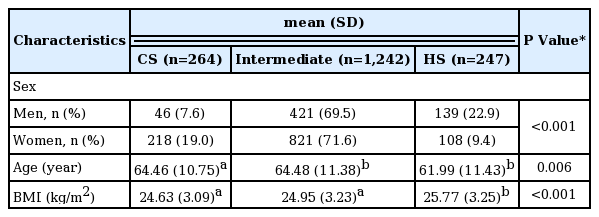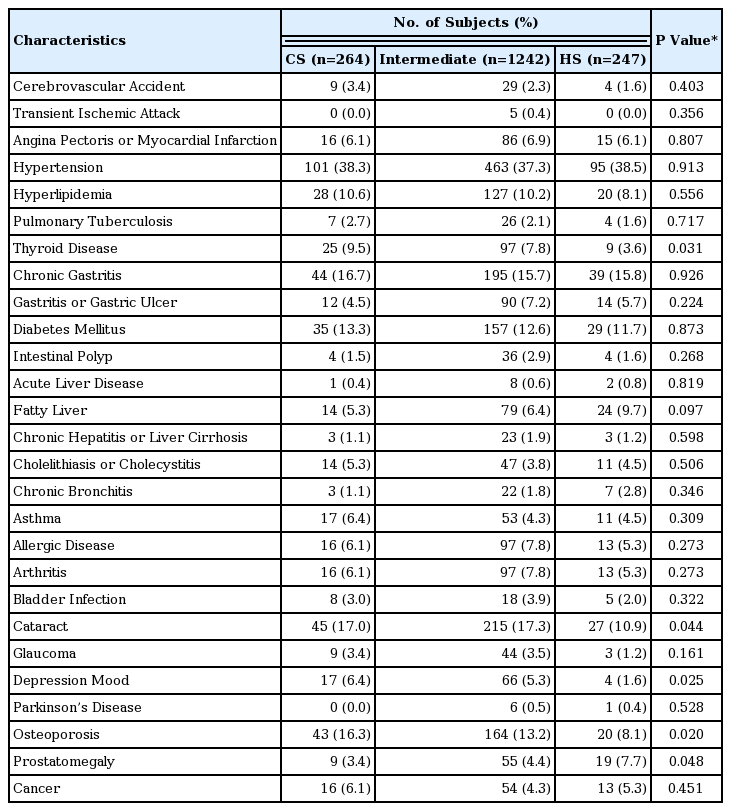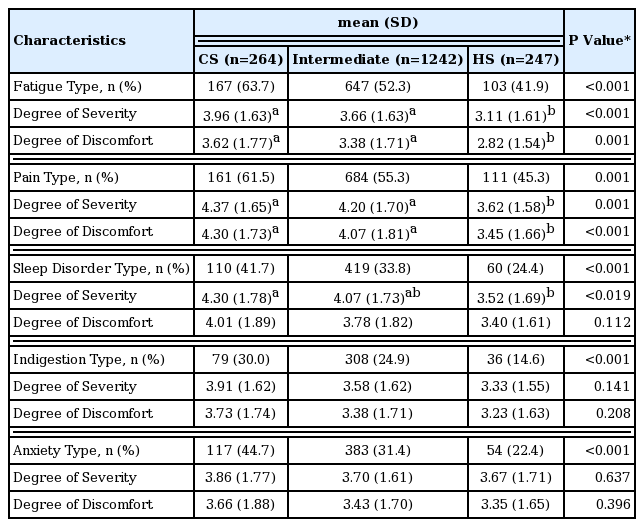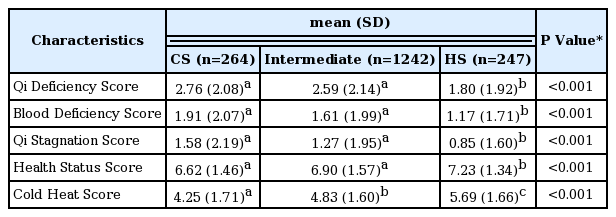References
1. Jiang M, Lu C, Zhang C, Yang J, Tan Y, Lu A, et al. Syndrome differentiation in modern research of traditional Chinese medicine. J Ethnopharmacol 2012;140(3):634–42.
2. Kim JH. A Comparative Research of Eight Principle Pattern Identification-based on Zhang Jie-Bin, Cheng Guo-Peng, and Jiang Han-Tun-. J Oriental Medical Classics 2013;26(2):47–59.
3. Shin SW, Kim JB. A Study on the Diagnostic System in ≪Shang Han Za Bing Lun≫. Korean J Oriental Medical Pathology 1998;12(1):1–18.
4. Yeo MK, Park KH, Jang ES, Lee YS. A National Survey on Utilization of Pattern Identification among Korean Medicine Doctors. J Society of Preventive Korean Medicine 2015;19(3):45–55.
5. Jiang M, Lv AP. A cold/heat property classification strategy based on bio-effects of herbal medicines. Zhongguo Zhong Yao Za Zhi 2014;39(11):2149–52.
6. Kim SK, Nam TH, Park YB. Validity of Questionnaires for Cold-Heat Patternization (I). J Korea Institute Oriental Medical Diagnostics 2002;6(2):141–56.
7. Kim SK, Park YB. Development of Questionnaire for Cold-Heat Patternization. J Korea Institute Oriental Medical Diagnostics 2003;7(1):64–75.
8. Park JJ, Lee MS, Kong KH, Go HY. Relationship between Heart Rate Variability and Cold-Heat Patternization in Patient with Chronic Constipation. Korean J Orient Int Med 2012;33(2):209–21.
9. Song JY, Kim MJ, Sung WS, Kim PK, Goo BH, Kwak HY, et al. Efficacy and Safety of Herb Medication According to Cold-heat Tendency of Knee Osteoarthritis Patients. J Korean Acupuncture & Moxibustion Med Society 2012;29(5):97–108.
10. Kang BG, Kang BK, Lee JS, Han DJ, Nam SK, Shin SH, et al. Study of the Specific Indicators Calculation of Fire-Heat Pattern Identification and Yin Deficiency Pattern Identification in Stroke. Korean J Oriental Physiology & Pathology 2008;22(6):1368–73.
11. Baek TS, Park YJ, Park YB, Park JH, Im JJ. Health Test for Searching of Correlation and the Index of the Cold-heat Patternization Comparison of the Questionnaires for the Cold-heat Patternization and the Ordinary. J Korea Institute Oriental Medical Diagnostics 2005;9(2):145–52.
12. Choi SO, Park SY, Jeong HJ, Jung SY, Ahn SY, Kim KM, et al. Clinical Study on Relationship between Pattern Identifications and Heart Rate Variability. Korean J Oriental Physiology & Pathology 2013;27(3):318–26.
13. Baik YS. A Study on The Changes of Concept of Syndrome Differentiation in The History of Traditional Medicine - Focusing on meaning and process -. J Korean Medical Classics 2014;27(4):133–51.
14. Kim WH. The Productive Mechanism of Han-Yoll(Cold and Heat) in Oriental Medicine. J Korea Institute Oriental Medical Diagnostics 2000;4(1):1–12.
15. Bae NS, Park YJ, Oh HS, Park YB. Preceding Studies for Questionnaires on Han-Yol Patternization. J Korea Institute Oriental Medical Diagnostics 2005;9(1):98–111.
16. Yeo MK, Lee YS. Analysis of Clinical Research Trends on Cold-Heat Pattern Identification in Korea - Focused on Quantitative Indicators for General People. 1. Korean J Oriental Physiology & Pathology 2017;31(2):145–52.
17. Kim MK, Lee IW, Shin AS, Kim NH, Kim HM, Shim SR, et al. The Comparison on the General Characteristics of Acute Stroke Patient between Heat pattern group and Cold Pattern Group. Korean J Joongpoong 2010;11(1):18–25.
18. Li S, Zhang ZQ, Wu LJ, Zhang XG, Li YD, Wang YY. Understanding ZHENG in Traditional Chinese Medicine in the Context of Neuro-endocrine-immune Network. IET Syst Biol 2007;1(1):51–60.
19. Ma T, Tan C, Zhang H, Wang M, Ding W, Li S. Bridging the Gap between Traditional Chinese Medicine and Systems Biology: the Connection of Cold Syndrome and NEI Network. Mol Biosyst 2010;6(4):613–9.





